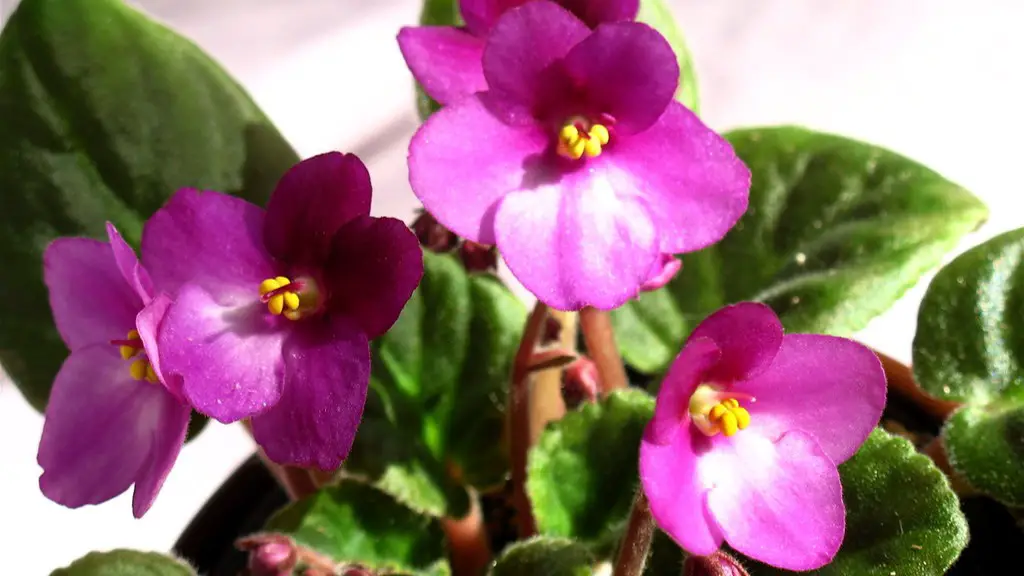If you would like to have success with African violets, there are a few tricks you can do to make sure they thrive. First, you will want to make sure that you are using a sterile potting mix specifically for African violets. You can find this at most nurseries or gardening stores. African violets also like to be in a humid environment, so you may want to invest in a humidity tray or pebble mat. These can also be found at most nurseries or gardening stores. Finally, be sure to fertilize your African violets regularly with a water-soluble fertilizer made specifically for them.
There are a few key things to remember when growing African violets successfully. They prefer bright, indirect light and weekly watering with lukewarm water. The soil should be moist but not soggy, and African violets do best when fertilized regularly. Be sure to allow the soil to dry out slightly between waterings to prevent root rot. With a little care, your African violets will thrive!
How often should a African violet be watered?
If you only water your African violets once a week, it’s important to allow the plant to completely dry out between waterings. One way to make sure your violets are never over-watered is to set up a wicking system.
If you are wondering whether to water your African violets from the top or bottom, know that either method is fine. However, it is important not to use cold water; lukewarm or warm water is preferred. If you water from the top, be careful not to get water on the leaves when the plant is in the sun; this is to avoid leaf spots.
How do I get my African violet to bloom again
African Violets are a type of flower that is known to bloom brightly and beautifully. However, sometimes they can lose their bloom and become lackluster. If this happens to your African Violet, don’t worry! There are ways to help it regain its bloom.
First, make sure that it is getting enough light. African Violets need bright, indirect light in order to bloom properly. If it is not getting enough light, try moving it to a brighter spot.
Next, turn up the humidity. African Violets love humidity, so increasing the humidity around them can help them to bloom again. One way to do this is to mist them with water every day.
Third, replenish essential nutrients. African Violets need nutrients like nitrogen, phosphorus, and potassium in order to bloom. You can replenish these nutrients by fertilizing your African Violet with a special African Violet fertilizer.
Fourth, keep it pleasant. African Violets like to be in cool, comfortable environments. Make sure that your African Violet is not in a place that is too hot or too cold.
Fifth, choose the right soil. African Violets need a light, airy soil that drains well. You can find special
If you want to bring more color into your home without a trip to the paint store, try adding more flowers to your favorite plants. African violets are especially good for this purpose, as they will bloom more prolifically when fed with Miracle-Gro® Blooming Houseplant Food. This will brighten up your home without any of the hassle or expense of painting.
Should African violets be misted?
When watering your African violet, be careful not to mist the foliage as this can cause permanent leaf spotting. Use water that is room temperature and make sure the crown (the section of the plant at soil level) is not saturated with water as this can lead to crown rot.
If you have overwatered your African Violet plant, you will need to take steps to dry out the soil. This can be done by increasing the amount of light and air flow to the plant, and by letting the soil dry out completely between watering. If the leaves and stems have already turned soft or mushy, you can try to save the plant by trimming off the affected parts.
Do African violets need bigger pots?
As a general rule, African violets do best when they are slightly pot-bound. This means that you should choose a pot that’s on the smaller side, as it will help to encourage healthy growth. If you have a standard African violet plant, your starter pot should be about 3-4 inches in diameter.
If you’re African violet is finicky about its water, make sure the water is either tepid or at room temperature before giving it to your plant. It’s best to let it sit for 24-48 hours, but if you can’t, then let it stand for at least an hour.
Can I water African violets with tap water
If you are unsure about the quality of your tap water, it is best to err on the side of caution and use distilled or filtered water for your African violets. Chlorine levels can fluctuate depending on the time of year, and in some areas tap water may have high levels of chlorine, chloramines, or dissolved solids. These things can all adversely affect your African violets, so it is best to use distilled or filtered water if you are unsure about the quality of your tap water.
Epsom salrts are a great way to provide your plants with essential magnesium and sulfur. These two minerals are needed to produce beautiful blooms and healthy foliage. To use, mix one and a half teaspoons of Epsom salts in a quart of tepid water and swirl to dissolve. Water your African violets (below the leaves) with this solution once a month.
What causes African violets not to bloom?
If you want your African violet to bloom well, make sure it gets plenty of light. However, be careful not to put it in direct sunlight, as this can burn the leaves. An east-facing window is ideal, especially if you can filter the light with a sheer curtain.
If you want your African violets to bloom year-round, you need to provide the correct conditions. African violets need bright, indirect sunlight and well-drained soil. They also need to be kept moist, but not wet. Allow the soil to dry out slightly between watering. Expect your African violets to bloom 10-12 months each year. Each bloom lasts for about 2-3 weeks.
Is baking soda good for African violets
If you have powdery mildew on your African violets and it’s not improving, try spraying the plants lightly with a mixture of baking soda and water. You can also spray the air around the plant with Lysol or another household disinfectant, but be careful not to get too much spray on the leaves.
African violets need a fertilizer with a ratio of 14-12-14. Urea is the recommended nitrogen source for African violets.
Can I use regular potting soil for African violets?
If you want to grow healthy African violets, it’s important to create the right growing conditions. African violets prefer slightly acidic conditions, between 58 to 65 pH. In conventional soil, your plant won’t be able to efficiently absorb nutrients. Generally, peat moss is used to lower the pH in African violet potting soil. By creating the right environment, you’ll be sure to have healthy and beautiful plants.
African violets are best suited for indoor growth in North America due to the necessity for their leaves to remain dry. Bright, indirect light will produce the best coloration and blooming results for these plants. An appropriate location for growth would be a plant stand three feet away from a west- or south-facing window.
Conclusion
Several factors are important for African violets to thrive, including:
– choosing a location with bright, indirect light
– providing consistent moisture, without letting the soil dry out completely
– using a well-draining potting mix
– feeding regularly with a high-quality African violet fertilizer
– keeping an eye out for pests and diseases, and taking care of them promptly
In order to make African violets thrive, it is important to give them the proper amount of light and water. African violets need to be in a bright spot, but not in direct sunlight. They also like to be kept moist, but not too wet. With the proper care, African violets can thrive and add a splash of color to any room.




